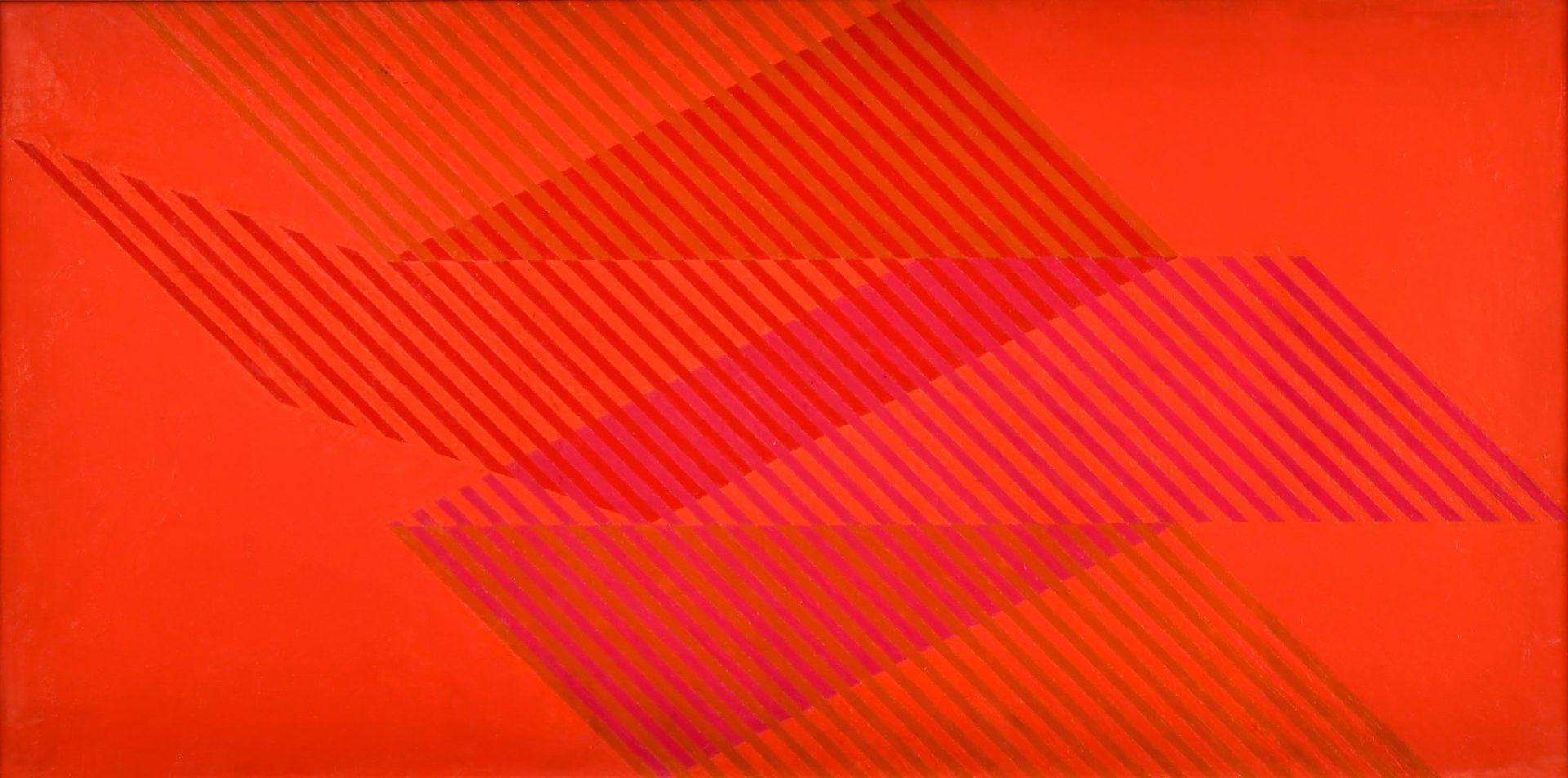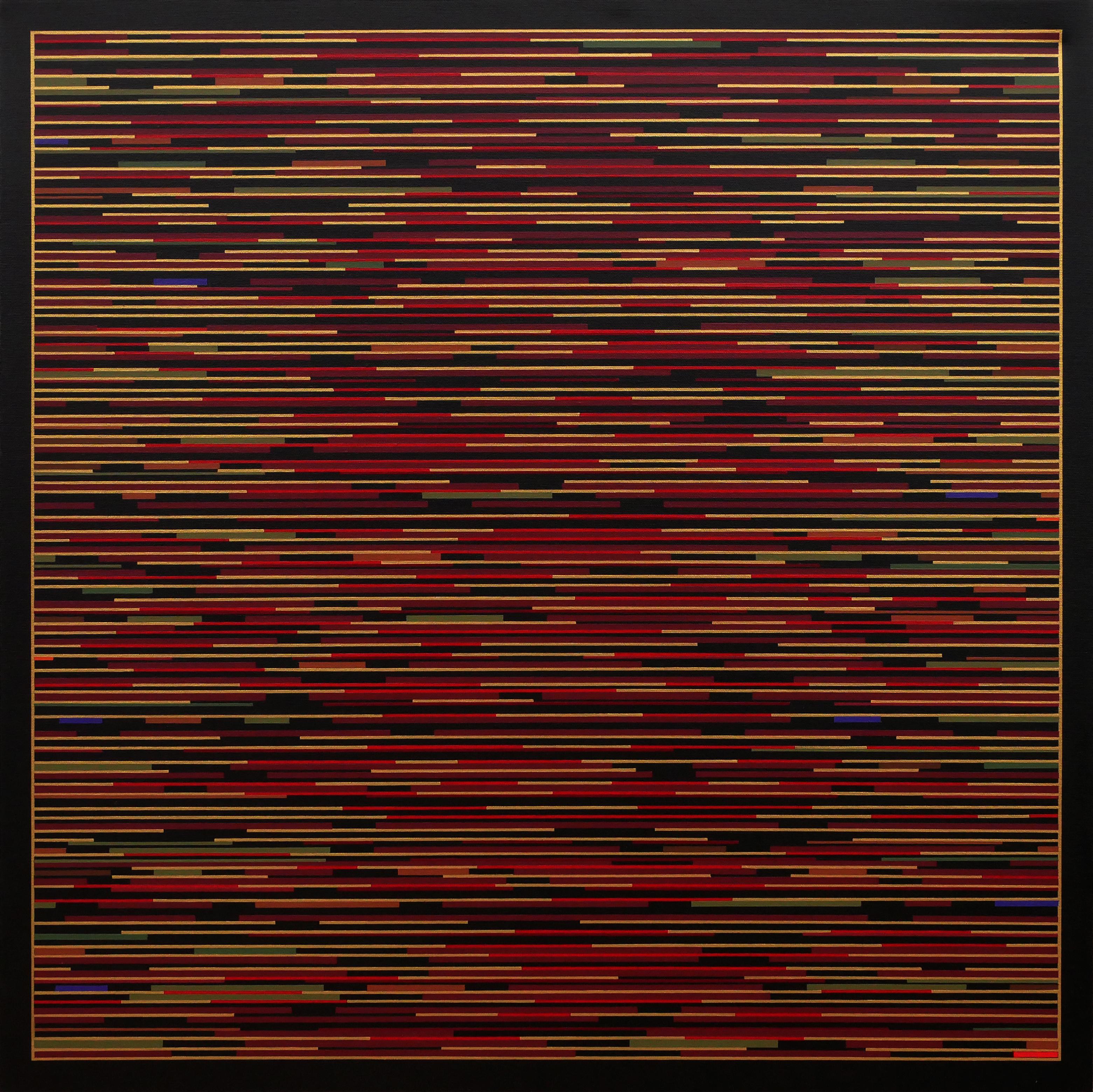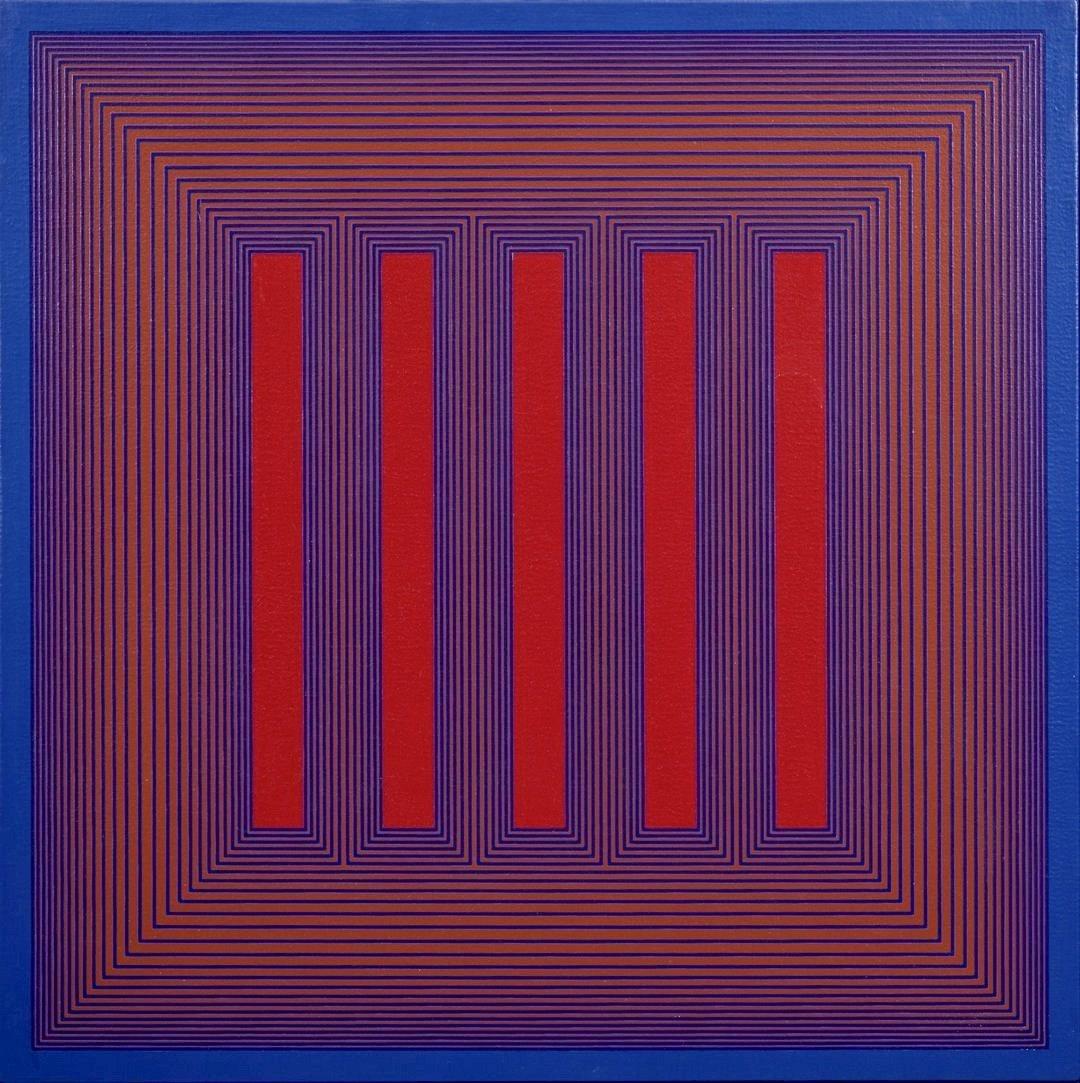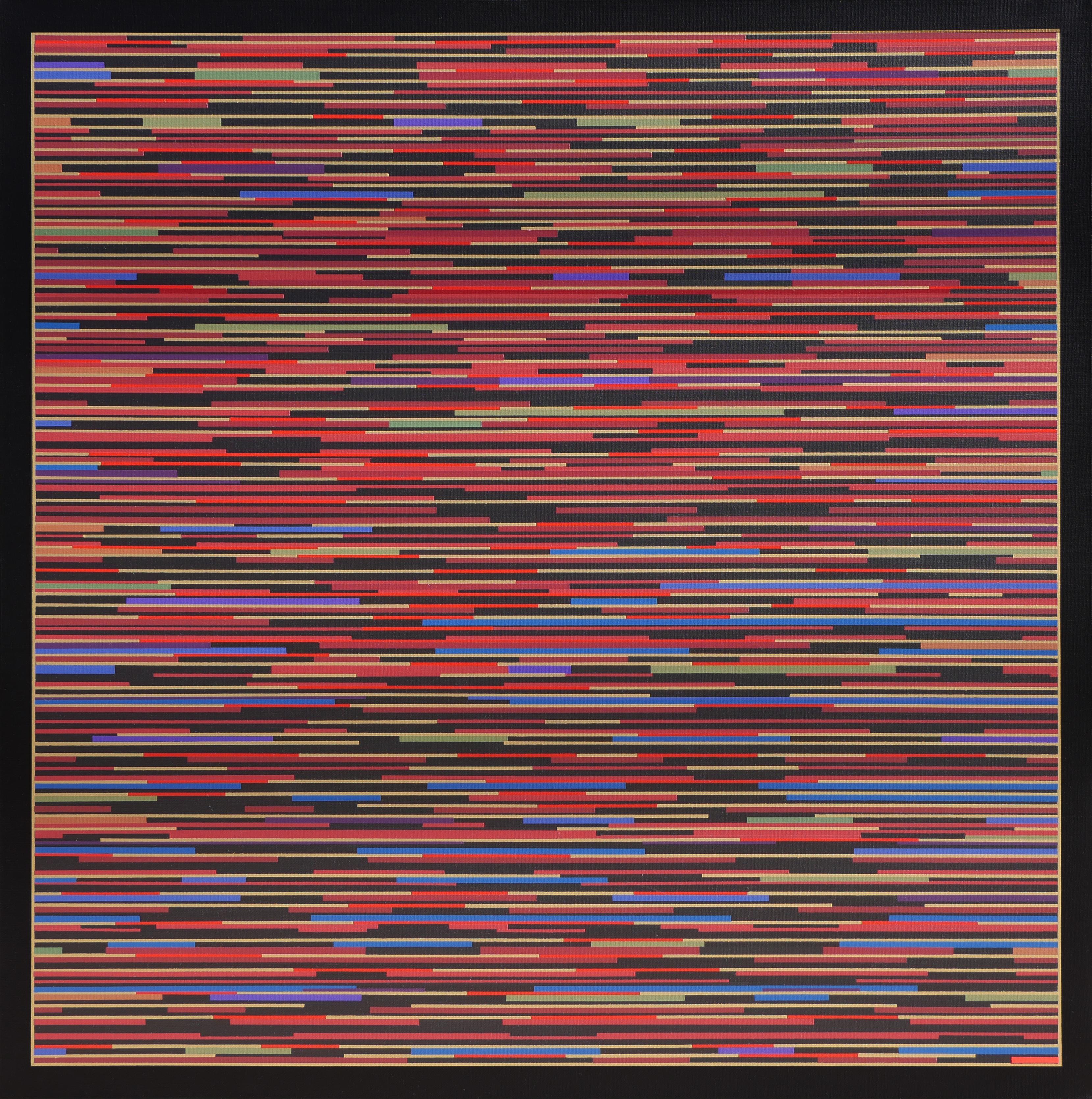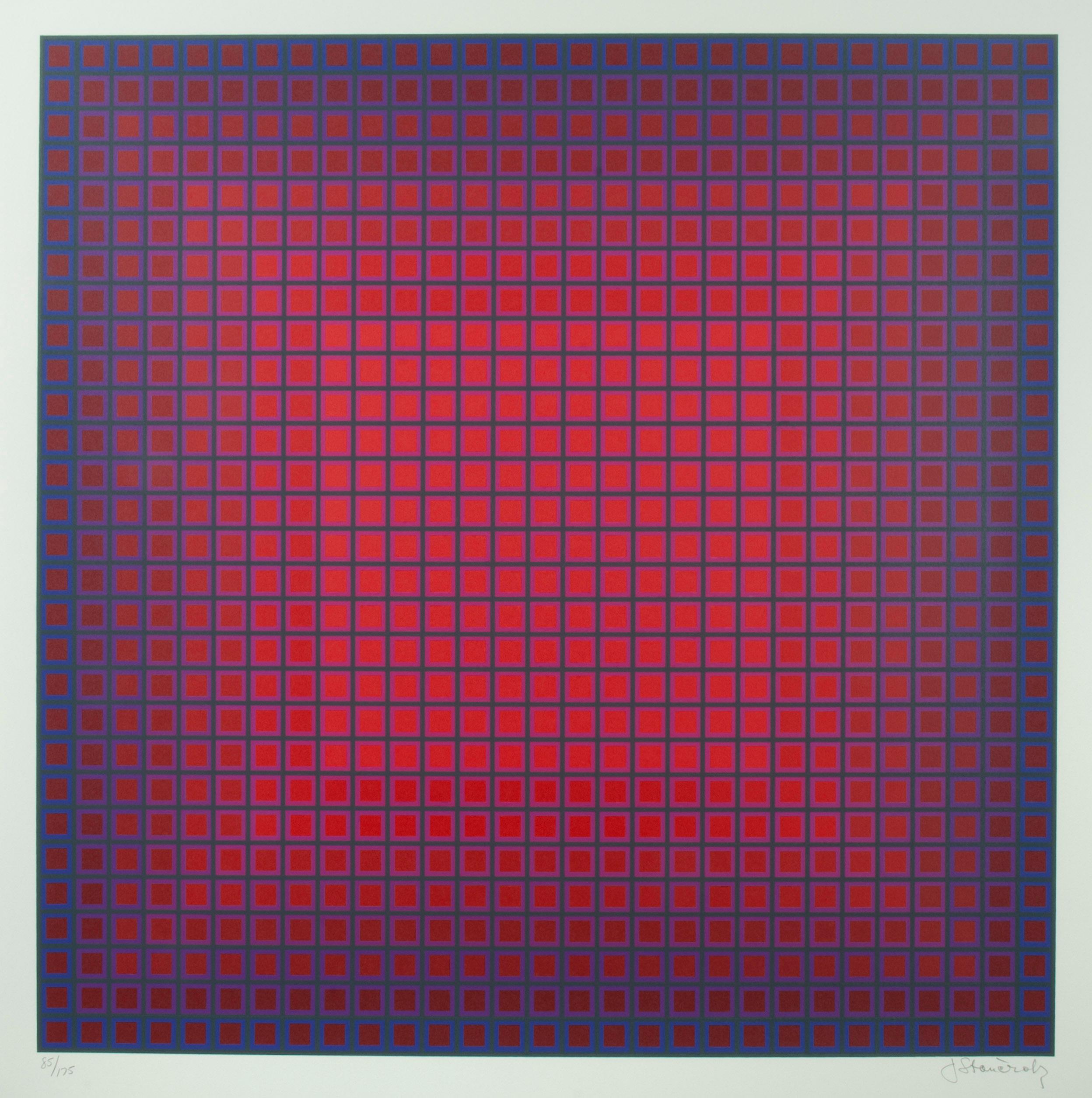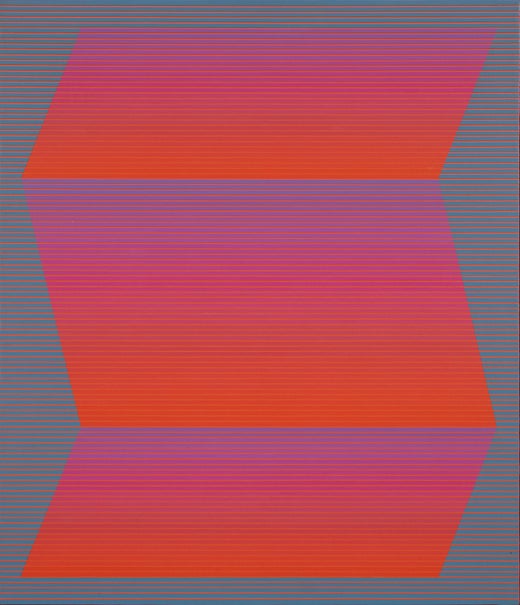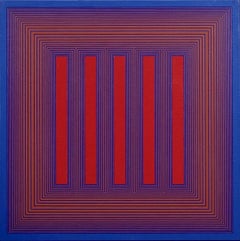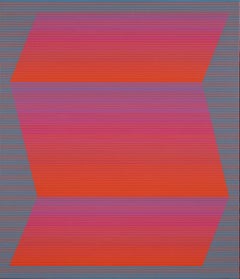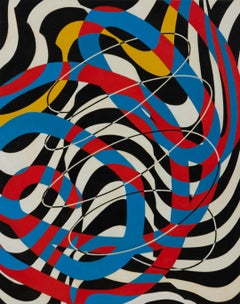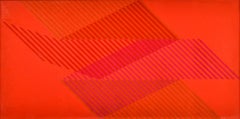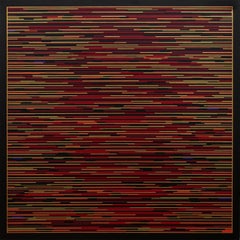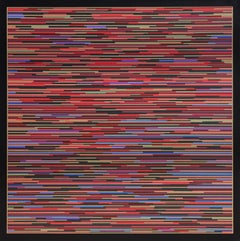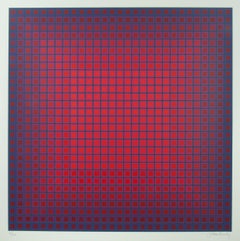Items Similar to Red is a Red, OpArt red geometric acrylic painting
Video Loading
Want more images or videos?
Request additional images or videos from the seller
1 of 16
Julian StanczakRed is a Red, OpArt red geometric acrylic painting1969
1969
$51,000
£37,864.79
€44,122.90
CA$70,804.47
A$79,199.25
CHF 41,215.76
MX$974,969.82
NOK 524,349.84
SEK 491,943.52
DKK 329,200.82
Shipping
Retrieving quote...The 1stDibs Promise:
Authenticity Guarantee,
Money-Back Guarantee,
24-Hour Cancellation
About the Item
Julian Stanczak (American, 1928–2017)
Red is a Red, 1969
Acrylic on canvas
Signed, dated and titled verso
28 x 28 inches
29 x 29 inches, framed
OpArt red geometric acrylic painting
Julian Stanczak (American, b. November 5, 1928) was an American painter and printmaker. He was born in Borownica, Poland. When World War II broke out, he was sent to a concentration camp in Perm, Siberia. Stanczak had been right-handed before he lost the use of his right arm for good at the camp. In 1942, after successfully escaping from the camp, Stanczak joined the Polish army-in-exile in Persia but soon deserted from it. After that, the artist spent his time in a Polish refugee camp in Uganda, Africa. This was where Stanczak learned to write and paint with his left hand, and where he took his first private art lessons. He then went to Borough Polytechnic Institute in London before immigrating to the United States in 1950. Four years after his immigration, Stanczak received his BFA from the Cleveland Institute of Art. In 1956, Stanczak became a United States citizen. It was also in 1956 that he received his MFA from Yale University under the training of Josef Albers (German-born American, 1888–1976) and Conrad Marca Relli (American, 1913–2000).
Stanczak's first major solo exhibition took place at the Martha Jackson Gallery in New York. Julian Stanczak: Optical Paintings was named after the Op Art movement. His work was also exhibited in the Museum of Modern Art's 1965 exhibition The Responsive Eye . In the early 1960s, Stanczak took advantage of the use of wavy lines and contrasting colors to make the surface plane of his works more vibrant. The work Provocative Current(1965) is a notable example of this unique style. This style of painting also paved the way for more complex artworks constructed with the rigidity of different geometrical shapes; however, it maintained the softness with many levels of color transparency. Netted Green (1972) is a famous work representing this style. Stanczak uses the same form again and again to produce compositions that reflect his visual experiences. His works are mainly based on the structures of color. In the 1980s and 1990s, Stanczak kept the geometric formation in mind, and produced bright-colored or muted-colored paintings often as pieces in a series such as Soft Continuum(1981).
In 1970, Stanczak was recognized as "Outstanding American Educator" by the Educators of America. He lived and worked in Seven Hills, OH, with his wife, the sculptor Barbara M. Meerpohl before his death on March 29, 2017.
- Creator:Julian Stanczak (1928, American)
- Creation Year:1969
- Dimensions:Height: 29 in (73.66 cm)Width: 29 in (73.66 cm)
- Medium:
- Movement & Style:
- Period:
- Condition:
- Gallery Location:Beachwood, OH
- Reference Number:1stDibs: LU176829687592
Julian Stanczak
Julian Stanczak was born in Borownica, Poland in 1928. At the beginning of World War II, Stanczak was forced into a Siberian labor camp, where he permanently lost the use of his right arm. He had been right-handed. In 1942, aged thirteen, Stanczak escaped from Siberia to join the Anders' Army in Persia. After deserting from the army, he spent his teenage years in a hut in a Polish refugee camp in Uganda. In Africa, Stanczak learned to write and paint left-handed. He then spent some years in London, before moving to the United States in 1950. He settled in Cleveland, Ohio. He became a United States citizen in 1957, taught at the Cincinnati Academy of Art for 7 years. The Op Art movement was named after his first major show, Julian Stanczak: Optical Paintings, held at the Martha Jackson Gallery in New York in 1964. His work was included in the Museum of Modern Art's 1965 exhibition The Responsive Eye. In 1966 he was named a "New Talent" by Art in America magazine. In the early 1960s he began to make the surface plane of the painting vibrate through his use of wavy lines and contrasting colors in works such as Provocative Current (1965). These paintings gave way to more complex compositions constructed with geometric rigidity yet softened with varying degrees of color transparency such as Netted Green (1972). In addition to being an artist, Stanczak was also a teacher, having worked at the Art Academy of Cincinnati from 1957–64 and as Professor of Painting, at the Cleveland Institute of Art, 1964-1995. He was named "Outstanding American Educator" by the Educators of America in 1970. (Wikipedia)
About the Seller
5.0
Vetted Professional Seller
Every seller passes strict standards for authenticity and reliability
Established in 1975
1stDibs seller since 2022
30 sales on 1stDibs
Typical response time: 9 hours
- ShippingRetrieving quote...Shipping from: Beachwood, OH
- Return Policy
Authenticity Guarantee
In the unlikely event there’s an issue with an item’s authenticity, contact us within 1 year for a full refund. DetailsMoney-Back Guarantee
If your item is not as described, is damaged in transit, or does not arrive, contact us within 7 days for a full refund. Details24-Hour Cancellation
You have a 24-hour grace period in which to reconsider your purchase, with no questions asked.Vetted Professional Sellers
Our world-class sellers must adhere to strict standards for service and quality, maintaining the integrity of our listings.Price-Match Guarantee
If you find that a seller listed the same item for a lower price elsewhere, we’ll match it.Trusted Global Delivery
Our best-in-class carrier network provides specialized shipping options worldwide, including custom delivery.More From This Seller
View AllTemple of Evening Reds, 1983 Acrylic OpArt by Cleveland School Artist
By Richard Anuszkiewicz
Located in Beachwood, OH
Richard Anuszkiewicz (American, 1930-2020)
Temple of Evening Reds, 1983
Acrylic on canvas
Signed verso
36 x 36 inches
36.75 x 36.75 inches, framed
Richard Anuszkiewicz was born in E...
Category
1980s Op Art Abstract Paintings
Materials
Acrylic
Twist & the Rain Mid-Century OpArt Geometric Painting by Cleveland School artist
By Julian Stanczak
Located in Beachwood, OH
Julian Stanczak (American, 1928-2017)
Twist and the Rain, 1975
acrylic on canvas
signed verso
30 x 24 inches
Julian Stanczak (American, b. November 5, 1928) was an American painter...
Category
1970s Op Art Abstract Paintings
Materials
Acrylic
Double Focus II Mid-Century OpArt Abstract Geometric painting, Cleveland school
By Julian Stanczak
Located in Beachwood, OH
Julian Stanczak (American, 1928-2017)
Double Focus II, 1963
acrylic on canvas
signed and dated verso
33 x 40 inches
Julian Stanczak (American, b. November 5, 1928) was an American ...
Category
1960s Op Art Abstract Paintings
Materials
Acrylic
Colorful Abstract Geometrical Late 20th Century Painting by Ohio Artist
Located in Beachwood, OH
James Massena March (American, 1953-2021)
Untitled
Oil on canvas
30 x 24 inches
"My paintings are about space, form and energy. I generally start painting without preconceived notio...
Category
Late 20th Century Abstract Abstract Paintings
Materials
Oil
The Way Out, figural abstract vibrant orange geometric acrylic painting
By Clarence Holbrook Carter
Located in Beachwood, OH
Clarence Holbrook Carter (American, 1904-2000)
The Way Out, 1992
Acrylic on paper
Signed and dated upper right
24 x 30 inches
Figural abstract vibrant orange geometric painting.
C...
Category
1990s Abstract Abstract Paintings
Materials
Acrylic
Broken Ice, Large Mid-20th Century Gouache, Op Art Cleveland School Artist
By Edwin Mieczkowski
Located in Beachwood, OH
Edwin Mieczkowski (American, 1929-2017)
Broken Ice, 1976
Gouache and pencil on paper
Signed, dated (Feb. 2, 1976) and titled lower right
27.5 x 37.75 inches
35 x 45 inches, framed
Edwin Mieczkowski, born in Pittsburgh, was a leader of geometric and perceptual abstraction during the latter part of the 20th century. Mieczkowski's work first came to prominence in "The Responsive Eye" exhibition, the nation's first major exhibition of perceptual art, held at the Museum of Modern Art in New York in 1965.
Mieczkowski was also featured in the 1964 article in Timemagazine that first used the term "Op Art" to describe paintings that manipulated visual cues in order to reorder and excite viewers' perceptual responses.
With a complex aesthetic that over time has transcended mere tricks of optical art, Mieczkowski has spent nearly four decades producing geometrically paintings, drawings and sculptures, a genre of modern art that is known broadly as perceptual abstraction.
His output of static and dynamic forms create a body of work, still largely intact, that uses visually disorienting, meticulously arranged lines, dazzling kaleidoscopic colors, and alluring juxtapositions of hue and tone, to playfully and seductively present new challenges for the viewer's eyes. The desired result is an optical effect of perpetual motion, harmonics and rhythm. . . .
Along with Frank Hewitt and Ernst Benkert, Mieczkowski was a co-founder in 1959 of the Anonima* group that worked together in Cleveland and New York and declared itself free from the pressures of the art market and the pursuit of personal fame. Members of Anonima often left their works unsigned and vowed to shun the usual art market venues such as commercial galleries, biennials and competitions. Instead, they engaged in a rigorous, self-imposed program of painting exercises to explore the effects of geometry and color on visual perception.
Although Mieczkowski's work hung side-by-side in the MOMA "Responsive Eye" exhibition with such colleagues as Josef Albers, Victor Vasarely, Richard Anuszkiewicz, Morris Louis, Kenneth Noland, Carlos Cruz-Diaz, Ad Reinhardt and Bridget Riley, all of whom went on to considerable fame and fortune, Mieczkowski chose to eschew commercial exhibition and career promotion. Instead, he spent 39 years teaching at the Cleveland Institute of Art and quietly executing a number of public art commissions while independently pursuing his own intuitive explorations in geometric abstraction.
Mieczkowski pursued virtually no commercial sales of his work. Consequently, the body of work he left behind consists of hundreds of paintings, drawings and sculptures only recently viewed...
Category
1970s Op Art Figurative Paintings
Materials
Gouache, Pencil
You May Also Like
"Red" Sewell Sillman, Geometric Abstraction, Op Art, Red Colorist Composition
By Sewell Sillman
Located in New York, NY
Sewell Sillman
Red, circa 1958
Acrylic on masonite
18 x 36 inches
Upon attending Black Mountain College in Asheville, North Carolina, Sewell Sillman’s life was arguably altered for...
Category
1950s Abstract Abstract Paintings
Materials
Masonite, Acrylic
"VM 8" Red Striped Abstract Geometric Painting
Located in Houston, TX
Contemporary abstract geometric painting by artist Mark Byckowski. The work is featured in a series of paintings. The work features horizontal lines wit...
Category
Early 2000s Abstract Geometric Abstract Paintings
Materials
Acrylic, Canvas
"VM 9" Red Striped Abstract Geometric Painting
Located in Houston, TX
Contemporary abstract geometric painting by artist Mark Byckowski. The work is featured in a series of paintings. The work features horizontal lines with a variety of vivid colors of red, purple, green, and yellow, painted on a black background. Each work in the series features a bright red line at the bottom right corner. Signed, titled, and dated on reverse. Currently unframed, but options are available.
Artist Biography: Mark Byckowski was born March 18, 1957 in Chicago, Illinois. He remained in and out of the Chicago area until moving to Raleigh, North Carolina in 1990. In 2016 moved to Livingston, Texas where he currently resides.
At an early age, he began drawing, studying, and creating art which has continued throughout his life. His artwork has changed and evolved through different periods and styles that span for decades. In the early years, he was influenced by traditional representational artists and illustrators, then impressionism, surrealism, and the avant-garde of modernism captured his imagination. His artistic talent eventually led him to Northern Illinois University where he received Dean List Honors in Fine Art with an emphasis in studio painting. As a studio artist, he has produced a body of work in a variety of media painting, drawing, sculpture, print making, and computer art also known as digital art.
While in college the artist began searching for an original idea and style of his own. In 1979 when the first apple personal computers became available in the art department. He immediately knew the technology would eventually influence the direction of fine art in the future. It took time to learn how to program and explore the possibilities of computers as a new tool in the creation of art. Personal computers back then did not have the capabilities they have today and were not user-friendly. There were only two fine artists Mark Pinson and I working with computer technology back then. We worked on our own ideas and after completing the programs and turning them into paintings and drawings we collaborated and mounted a two-man exhibition.
My first program was a series of interconnected images entitled “Concatenation” paintings and drawings created from the program were exhibited with Mark Pinson’s work entitled “Random” in a two-man show at The Holmes Center Gallery, Northern Illinois University on November 30, 1980. The second program entitled “Visual Music” the paintings and drawings exhibited in a one man show at The Recital Hall Music Building Gallery, Northern Illinois University on April 26, 1981. Followed by an exhibit sponsored by Illinois Bell, works on paper selected a drawing from the Visual Music series for “A New Generation of Artists” at The Lobby Gallery, 225 West Randolph Street, Chicago, Illinois, May 14 through June 12, 1981.
The artist has participated in exhibitions dating back to 1974. The above exhibitions were selected because they marked a new beginning and direction in the artist’s work that continues to the present day.
Other positions held in the Fine Art field include:
1984-1985- Austin Galleries, Michigan Avenue, Chicago, Illinois (Main Gallery) and other locations Fine Art Consultant / Gallery Director
1982-1984- Atlas Galleries, Michigan Avenue, Chicago, Illinois (Main Gallery) and other locations Fine Art Consultant / Assistant Gallery Director
Artist Statement:
Subject matter for computer art, painting, and drawing
Mark S. Byckowski
In 1979 searching for a for an original idea and style of my own I began looking for abstract ideas that I could program with a computer for a new a paintings series. I decided on an idea called “Concatenation” a series beginning from the original image undergoing a transformational change from the previous image connected in a linked series.
Example: Image 1 is the original, image 2 changes image 1 by adding a new line, and image 3 changes image 2 by adding an additional new line. Continually changing the previous image by adding an additional line etc.
In 1980 I began working on a new abstract idea that I could again program with a computer for a new painting and drawing series. The similarities between music and art intrigued me and began thinking about how I could create a visual representation of musical sound. In music notes are arrangements turned into compositions. In art color is also, arranged into compositions and both seek aesthetic rhythms and harmony. Depending on what notes or colors used can also, affect different emotions and moods.
The Artists painting process
Step one: Create the computer drawing. For years I have used Microsoft classic paint to create drawings. It allows me to arrange an aesthetic composition and select a color scheme in advance. I can make changes easily until I am satisfied.
Step two: I build a custom stretcher frame with support bars and corner braces.
Step three: Measure and Stretch the canvas onto the frame pulling the canvas and using a staple gun...
Category
21st Century and Contemporary Abstract Geometric Abstract Paintings
Materials
Acrylic, Canvas
Compounded Red
By Julian Stanczak
Located in Fairlawn, OH
Signed and numbered in pencil
Publisher: Eugene Shuster, London Arts
Printer: Vistec Graphics, Rochester, New York
Stamp verso: London Arts Copyright 1980
Edition: 175 (85/175)
Category
1980s Op Art Abstract Prints
Materials
Screen
Red II, OP Art Screenprint on Panel by Anuszkiewicz
By Richard Anuszkiewicz
Located in Long Island City, NY
Artist: Richard Anuszkiewicz, American (1930 - )
Title: Untitled - Red
Year: 1991
Medium: Silkscreen on Panel mounted to Silkscreened Paper, signed and numbered in pencil
Edition: 6...
Category
1990s Op Art Abstract Prints
Materials
Screen
Red v. 2, Geometric Abstract Screenprint by Babe Shapiro
By Babe Shapiro
Located in Long Island City, NY
Artist: Babe Shapiro, American (1937 - 2016)
Title: Red v. 2
Year: 1972
Medium: Silkscreen, signed and numbered in pencil
Edition: 99
Image Size: 25 x 25 inches
Size: 35 x 35 in. (88...
Category
1970s Op Art Abstract Prints
Materials
Screen
